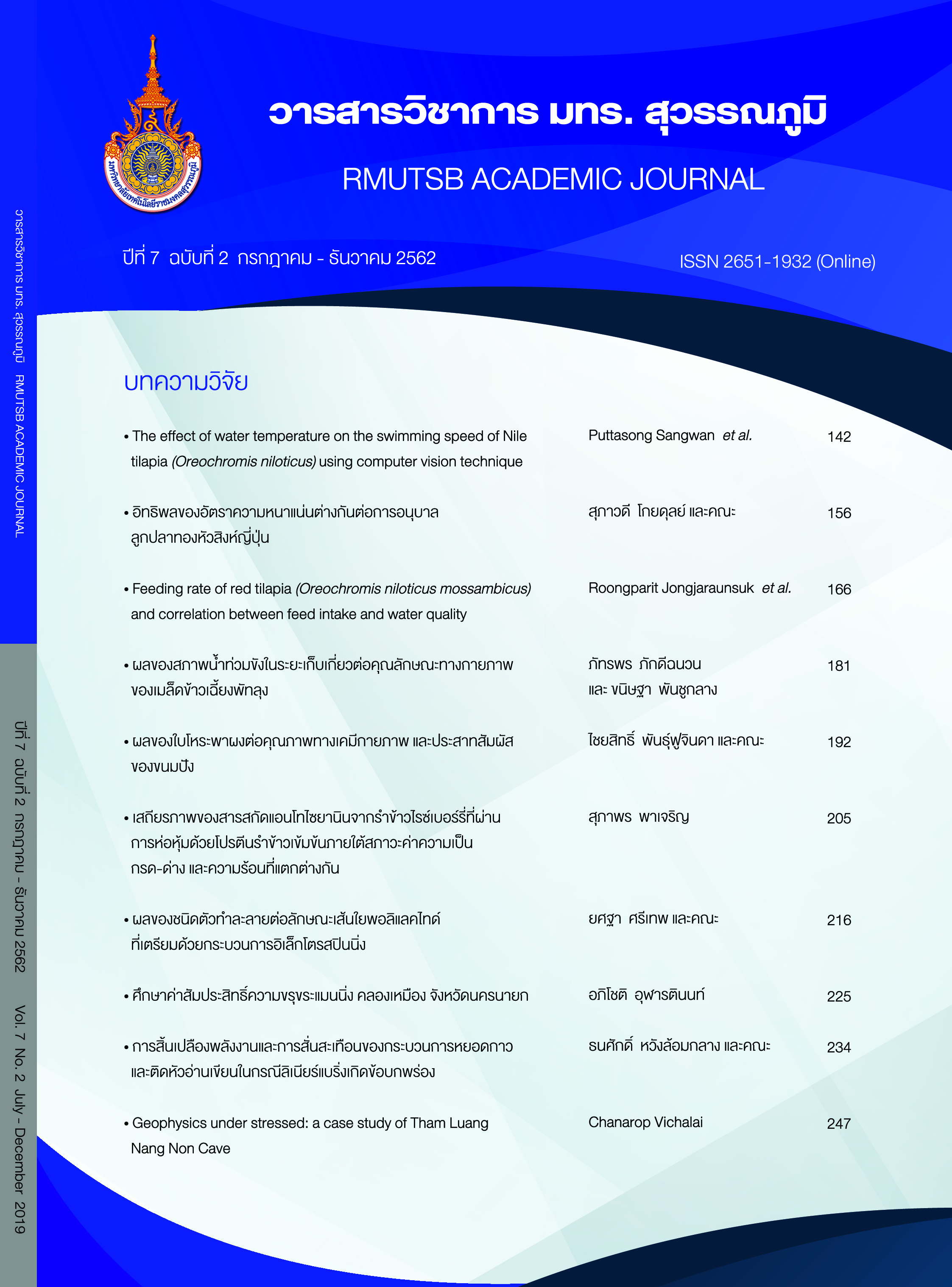Effects of ground dried basil leaves on chemical composition and sensory acceptance of bread
Main Article Content
Abstract
The aim of this study was to compare and investigate the quality of bread with 2, 3 and 4% by weight of dried basil leaves. The results showed the best formula was the one with 2% basil leaf substitute and it consisted of wheat flour 45.41%, fresh milk 21.80%, butter 10.90%, eggs 9.45%, white sugar 9.08%, yeast 1.83%, ground dried basil leaves 1.08% and salt 0.45%. Among the four samples, the 2% basil leaf substitution received the highest scores of sensory acceptances in terms of appearance and overall satisfaction (p≤0.05). While the L* and a* values decreased, the b* values increased when there were more additions of ground dried basil leaves. In terms of texture analysis, the value of hardness tended to increase while a decreased when the duration of keeping time increased. In terms of chemical composition, the 2% basil leaf substitution consisted of carbohydrates, fat, moisture, protein, ash and fiber at 47.31, 31.17, 13.13, 4.05, 3.54, and 0.80%, respectively. There were antioxidant contents <5.00 mg/100g and vitamin A 210 mcg RE per 100 g. The overall satisfaction with the bread with basil leaf substitution was 6.93. Regarding future purchase, 65% of consumer would buy the product. In sum, the 2% basil leaf substitution had higher sensory scores and nutritional values than bread without basil leaf substitution.
Article Details
Published manuscript are the rights of their original owners and RMUTSB Academic Journal. The manuscript content belongs to the authors' idea, it is not the opinion of the journal's committee and not the responsibility of Rajamangala University of Technology Suvarnabhumi
References
Apapat, S. (2016). Factors affecting purchase decisions by working-age consumers of take away bakery products in Bangkok and vinicity (Master’s thesis). Thammasat University, Pathumthani. (in Thai)
Brasil, J. A., Silveira, K. C., Salgado, S. M., Livera, A. V. S., Faro, Z. P., & Guerra, N. B. (2011). Effect of the addition of inulin on the nutrition, physical and sensory parameters of bread. Brazilian Journal of Pharmaceutical Science, 47(1), 185-191.
Heitragoon, P. (2010). Bread & sweetbun. Bangkok. Maeban Publishers. (in Thai)
Hui, H. Y., Corke, H., Leyn, I. D., Nip, W., & Cross, N., (2006). Bakery products science and technology. U.S.A.: Blackwell Publishing.
Ieowsakulrat, S. (2014). Physicochemical and sensory analysis of holy basil leaves (Ocimum sanctum) adding in breads. Agricultural Sci. J., 45(2), 161-164. (in Thai)
Jaitab, W. (2013). Factors affecting consumer’s buying decisions of bakery products in Bangkok (Master’s thesis). Bangkok University, Pathumthani. (in Thai)
Kongpim, P. (2009). Desorption isotherms and drying model of sweet basil leaves by hot air and heat pump dehumidified drying (Master’s thesis). Khon Kaen University, Khon Kaen. (in Thai)
Omer, M., Fikret, K., & Hikmet, G. (2003). The vitamin and selenium contents of apricot fruit of different varieties cultivated in different geographical regions. Food Chemistry Journal, 83(2), 205-212.
Panichakornkul, W. (2016). Effects of drying temperatures on quality of dried sernania flowers (Sesbania javacica Mig) and it’s application in bread. VRU Research and Development Journal Science and Technology, 11(1), 47-55. (in Thai)
Pavlova, T., & Nakov, G. (2019). The effect of adding basil whole plant powder (Ocimum basilicum L.) some properties of bread. Proceedings of University of Ruse - 2019 volume 58, book 10.3 (pp. 41-47). Ruse: University of Ruse.
Pongsawatmanit, R. (2002). Food product shelf-life evaluation and extension. Bangkok: Kasetsart University. (in Thai)
Pop, A., Petrut, G. S., Muste, S., Păucean, A., Mureșan, C., Salanta, L. C., & Man, S. (2016). Addition of plant materials rich in phenolic compounds in wheat bread in terms of functional food aspects. Hop and Medicinal Plants, 24(1/2), 37-44.
Prior, R. L., Wu, X., & Schaich, K. (2005). Standardized methods for the determination of antioxidant capacity and phenolics in foods and dietary supplements. J. Agric. Food Chem. 53(10), 4290-4302.
Raba, D. N., Moigrădean, D., Poiană, M., Popa, M., & Jianu, I. (2007). Antioxidant capacity and polyphenols content for garlic and basil flavored bread. Journal of Agroalimentary Processes and Technologies, 13(1), 163-168.
Sangchay, A., Kaveera, K., & Limroongreungrat, K. (2010). Effect of moringa leaves fortification on bread quality. Agricultural Sci. J., 41(3/1)(Suppl.), 349-352. (in Thai)
Supavitipatana, P. (1998). Herbal bread from roselle (research report). Phitsanulok: Rajabhat Institute Pibulsongkram, Phitsanulok. (in Thai)
Thumrongchot, D., Junlaya, W., & Wongpaisarnrit, R. (2012). Bread and bakery gluten free. Bangkok: Petchprakai Publishers. (in Thai)
Vanichbuncha, K. (2007). Data analysis SPSS for Windows (10th ed.). Bangkok: Thamasan Publishers. (in Thai)


